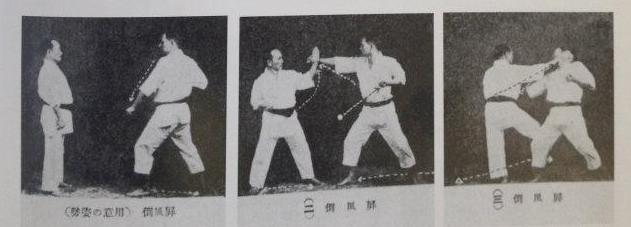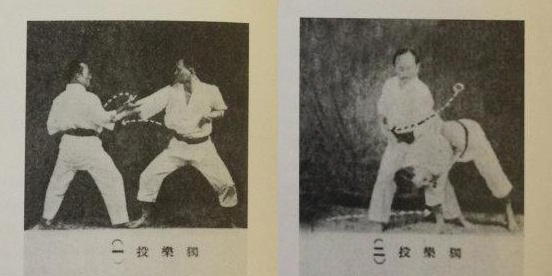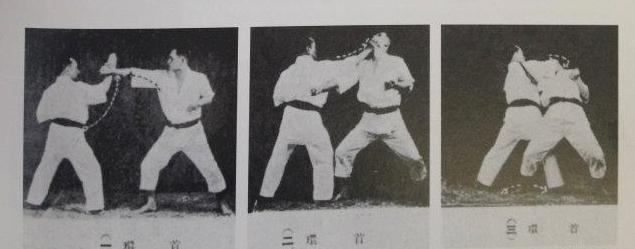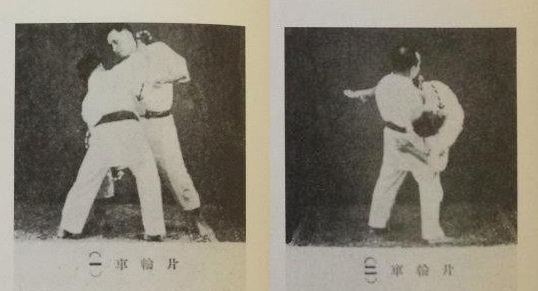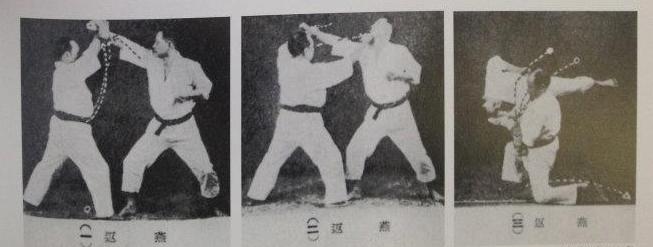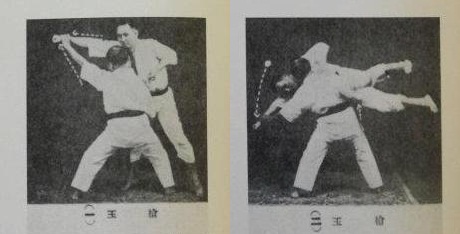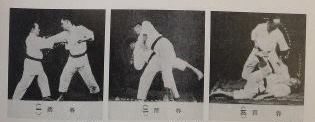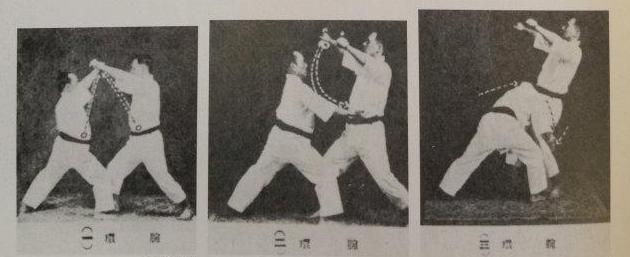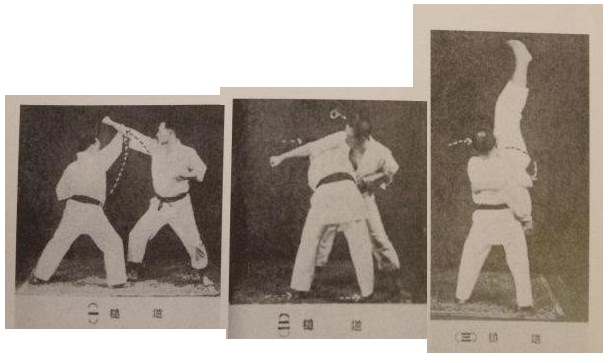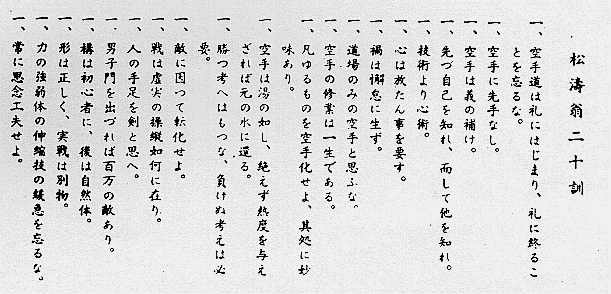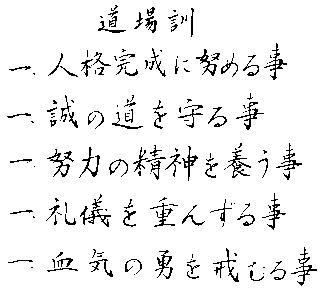Main Dojo Rules
SILVERADO Karate Dojo Rules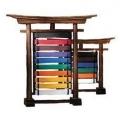
They are designed to help students know what to do in the dojo. The dojo is much more than a "training hall." It is the place where the spirit is forged through rigorous physical conditioning, self-discipline and introspection (looking within). The dojo has its own culture and it takes time to learn the proper procedures and rules. Karate goes back many hundreds of years and is influenced by Okinawan, Japanese and Chinese culture. Many rules, particularly those of etiquette, are unspoken. By this compilation, we are trying to make these rules more easily understood. You should ask the Sensei or a senior if you have any questions.
We practice the Japanese Art of Shotokan (Shōtōkan-ryū) is astyle of karate, developed from various martial arts by Gichin Funakoshi (1868–1957) and his son Gigo (Yoshitaka) Funakoshi (1906–1945) and other Japanese Martial Arts.
The three most important maxims of Karate are:
- Karate begins and ends with courtesy (respect)
- Karate polishes the spirit (refinement)
- There is no first attack in Karate (restraint)
1. About the use of Karate:
- "Karate ni sente nashi" -- "There is no first attack in Karate."
- Karate techniques should only be used for self-defense, as a last resort, and then only to the extent necessary. It is best to avoid a fight. If confronted, escape if possible.
- Karate techniques should only be used for a just cause, particularly to preserve life.
- Restraint is a great virtue in Karate. "A fist in the pocket is the best place for it." -- Mizuho Mutsu
- A skilled Karateka fears his own hand. He is therefore very reluctant to use it destructively.
- Remember that there are many people more skilled than you. Never underestimate an opponent.
- Do not give away the fact that you are trained in Karate. Surprise gives you an advantage. Bragging about your "skills" is foolish and invites conflict.
- Most people are attacked without warning. Awareness, anticipation and avoiDance are the best self-defense.
2. About courtesy (briefly):
- Follow the rules of etiquette and courtesy (respect). "Karate begins and ends with courtesy."
- Remember to respect yourself, as well as others.
- A Karateka should be a gentleman. Remember to say "please," "thank you" and "you're welcome." Hold doors open for others.
- Anticipate a need. Remember the expression "if I have to ask, I won't ask."
- Ask your seniors if you are not sure what to do in a situation. Consulting the senior shows respect.
- Consider the consequences of your actions. Think before you speak, particularly if you are angry.
- Courtesy, character development, self-discipline and restraint take precedence over technique.
- Bow when entering and leaving the dojo. Keep your eyes slightly lowered when bowing, but maintain awareness.
- Shoes and slippers should be neatly arranged outside in the hall. "Leave the world in your slippers," means do not bring your troubles into the dojo.
- When we line up at the beginning and end of the class, the Sensei stands in the front of the class. Visiting dojo owners and Sensei of a high level also stand in front of the class. In the beginning of class, we should say "onegaishimasu Sensei" which means "please teach me or do me a favor, Sensei." At the end of class, we should say "arigato gozaimasu Sensei" which means "thank you, Sensei." When we bow to the Sensei, we are showing respect to the Sensei and he is showing respect to us. When we bow to the shinden (shrine at the head of the class), we are showing respect to all the teachers of the art going back for hundreds of years.
- If a Sensei arrives late or leaves early, the class should be brought to attention by the senior student and show the proper courtesy.
- When arriving to class late, bow to the Sensei, seiza, mokuso (Japanese term for meditation), then warm-up and wait for permission to join the class.
3. About the dojo structure and interaction with other dojos:
- In any dojo there is only one Main Sensei (head of the dojo). Senpai (senior students) and Kohai (junior students)
- Remember that we are a dojo, not a class or loose training group.
- Address teachers as "Sensei," not by their first names. Say "Silvera Sensei," rather than "Sensei Silvera." YuDansha (holders of black belts) are usually not addressed as "Sensei" until they attain the rank of sanDan (3rd degree black belt) or become the head of a dojo. Adults should be addressed by children as Mr., Mrs. or Ms.
- A Sensei does not address himself as such -- other people refer to him as "Sensei." It is best not to use the title "Sensei" in business cards, letterhead, etc. Be careful -- if the Sensei identifies himself by his first name, you should still refer to him as "Sensei."
- Consult with your Sensei before training in another art (such as Aikido, Iaido, Judo, Kendo, etc.).
- Respect other styles but practice your own. Knowing "a little of this" and "a little of that" usually ends up being "a lot of nothing." If you practice more than one style or art, keep them separate until you are very advanced.
- Be very courteous when visiting another dojo to observe. Remember that you represent our dojo.
- Request written permission from your Sensei before training at another Karate dojo. Your Sensei will probably give you a letter of introduction to carry to the Sensei of the other Karate dojo. Do not go empty handed. Bring an omiyage (thoughtful gift) and your letter of introduction. The two Sensei will usually consult each other before a visit. When training at another dojo, you must follow their dojo rules. You should also make sure to pay the necessary tuition and sign the necessary consent forms. Remember that you cannot have two Sensei in one style. You can only belong to one dojo and be a guest in another.
- If you train regularly at another Karate dojo that is not a member of our association, you must not wear our patch. To do so would be disrespectful to that dojo. You should not wear your black belt if you train at dojo that teaches another style of Karate (unless you are ranked in that style too). Remember that dojo outside of our association may not recognize your rank even if they teach ShotoKan.
- Guests at our dojo must present a letter of introduction from their Sensei. This does not apply to heads of dojo or senior Sensei.
- Treat visiting instructors with the same respect you would show to your Sensei.
- Request permission before demonstrating Karate, unless it is part of a dojo activity.
- Do not teach anyone outside of class unless you receive permission to do so. Do not teach or show what you learn in our dojo in another dojo (it would be disrespectful to the Sensei of the other dojo to do so).
4. About life and priorities:
- Your family, and work or school come first. Come to class only after you have fulfilled these obligations. When you take care of your family, do a good job at work, and try your best at school, you are being a good Karate student!
- Karate is not a religion. When we practice Mokuso (Japanese term for meditation), we are simply sitting quietly, not praying.
- Learn to apply Karate in your daily life. Don't confuse class (a few hours each week) with training (24 hours each day).
- "Mazu sono kokoro wo tadase" -- "First purify your spirit."
- Karate polishes the spirit (kokoro). In Japanese, kokoro means spirit, heart, mind and character -- the totality of one's being. Karate polishes (or refines) the entire person.
- Karate is an art -- not a sport, simple athletics or a Dance. It requires a lifetime of practice because the subject is your life, not merely self-defense.
- For children, obey your parents and respect your elders. For parents, try your best to be a good example for your children.
- Karate should help to make you a better person. If it doesn't you should carefully examine your training -- something must be wrong.
5. About Attendance:
- All students (or their parents, as applicable) must sign a consent form before training.
- Come to class to learn. Practice at home.
- Children should be dropped off and picked up at the dojo -- not in the parking lot.
- Come to class 15 minutes early to help sweep, mop, and chairs, clean mirrors, and warm-up. Help clean up after class. The seniors should set a good example by cleaning the dojo. You never become too high ranking to help -- in fact, just the opposite is true!
- Being prompt is part of your training.
- Always let the Sensei know if you are suffering from an injury, illness or require special assistance. Do not come to class when suffering from a contagious illness. Rest and come back to class when you have fully recovered.
- Let the Sensei know if you must leave class early. Show the proper courtesy when leaving the class early.
- Let the Sensei know if you will miss class for an extended period. Sensei can be called or texted at (734) 658-5834.
- Let the Sensei know when you decide to quit training or take an extended leave of absence. End with a sense of courtesy. You might want to donate your gi to another student.
6. About health and hygiene:
- Keep your body clean.
- Keep your fingernails and toenails short and neatly trimmed.
- Long hair should be neatly pulled back, preferably with a black tie. Do not wear metallic or plastic items in the hair.
- Bring bottled water to class. Drink plenty of water during breaks. Sugar-sweetened beverages are not recommended to drink.
- There is much to be said about the recommendation to "exercise regularly, stand straight, drink plenty of water, take your vitamins, and get enough rest."
7. About the gi (uniform):
- Keep your gi clean. Wash it after each use.
- The gi top and obi (belt) should be put on after arrival to the dojo and removed before departure from the dojo. Do not wear the gi top and belt outside.
- Women and girls should wear a plain white T-shirt under their gi top.
- The obi generally should not touch the floor.
- The gi should be cut and hemmed to the proper length.
- The Dojo patch is worn on the left side.
- The Dojo patch should not be worn when training regularly at a non-association dojo.
8. Things that should not be done in the dojo:
- Do not wear jewelry, in the dojo. Karate is a traditional, conservative art. In addition, these things can cause injuries.
- Do not chew gum while training.
- Do not come to class when intoxicated. Do not consume any alcohol before class.
- Do not smoke in the dojo.
- Do not run or act recklessly in the dojo.
- Do not play with toys in the dojo.
- Do not speak loudly. Use a quiet voice in the dojo (except when leading the count).
- Do not use profanity or abusive language in the dojo.
- Do not become angry or upset in the dojo.
9. About effort:
- Try your best, but do not overdo it. You can always take a break when needed. Just let the Sensei or a senior know.
- Practice according to your age and ability. A 10 year old child and a 90 year old can both practice Karate, but their movements will reflect their respective life stages.
- Know your limits. Injuries often result when limits are exceeded. The older you become, the longer it takes to heal. So take it slowly.
- Everyone needs a break sometime, even from class. Karate is a marathon, not a sprint.
10. About tuition and Testing Fees:
- ALL members must be current in dues and training fees. All members must pay their monthly training fees on time. A Late Fee of $10 will be assessed for any installment received over 5 business days.
- Test fees must be paid prior to testing date for testing to occur.
- The fee payable for Kyu promotions is for the belt and certificate. For Dan promotions, the costs are considerably more.
11. About ranking:
- The Sensei alone determines ranking. A Sensei can promote to two levels below his own rank. Other black belts cannot promote students but may be asked to help to evaluate or test them.
- We only promote members of our dojo -- not guests or referred students.
- The minimum age for Shodan (1st degree black belt) in our dojo is 17.
- Never request to be tested or promoted. The Sensei will let you know when you will be tested or have been promoted.
- Kyu belt rankings; a minimum of 20 classes must be attended in each 3-month testing cycle in order to test. (Keep track of your classes). No Exceptions.
- There are minimum time periods between Dan rankings (two years for 2nd Dan, three years for 3rd Dan, four years for 4th Dan, etc). However, training for the minimum time period does not entitle the student to promotion. Many factors are involved in promotions such as time in rank, attendance, technique, teaching ability, helpfulness, attitude, courtesy, effort, contributions to the art, etc.
- Accept a promotion with a sensei of increased responsibility to your fellow students.
- Our dojo recognizes Dan rankings by the United States National Karate Federation. New students with Dan ranking from someone other than those mentioned should wear a white belt unless otherwise told to do so.. In the appropriate case, such a student may be able to obtain equivalent ranking after an appropriate review period. This rule only applies to students in our dojo -- not guests. Guests should wear their normal belts.
- If you return to the dojo after a lengthy absence, you should wear a white belt. The Sensei will let you know when you should wear your regular belt.
12. Attitudes for learning and teaching:
- Always maintain a beginner's heart (attitude). You can't learn something if you think you already know it.
- The most advanced thing is basics! Some experts say that it takes 20 years to learn basics.
- Never contradict or attempt to correct the Sensei. The way the Sensei does it is right. Discuss such matters with the Sensei privately.
- Always accept correction positively and with an open mind.
- Remember that Karate techniques differ according to the student's ability and experience. You will learn different ways to execute techniques as you progress. What you learned before was not wrong.
- It is far better to know one kata well than dozens of kata poorly!
- Teaching is an essential aspect of learning. Advanced students will be asked to teach and to help conduct the class. When you become advanced, remember that you were once a beginner too.
- There is a saying that in order to progress; one must bring up another student. Progress is never alone.
- As you advance, ego is a constant enemy. Remain humble.
13. About Kumite (sparring):
- Kumite should only take place under the supervision of a Sensei or YuDansha.
- Kumite is not a game or a contest. There is no winner or loser. The goal is to learn, not win. You do not have an opponent, you have a partner. You are both polishing your skills. In the real world, escape can be a victory.
- You must remain calm in kumite. Never become angry. You are learning to control your mind as well as your body.
- Never strike to the face, spine, groin, knees, or vital points. Strike the makiwara,or heavy bag, not people.
- Unlike tournament Karate, practical self defense is not bound by rules. Many Karate techniques cannot be used safely in jiyu kumite (free sparring). Such techniques are best practiced in controlled drills.
- Remember the maxim that "there is no first attack in Karate." Therefore, when you attack first in kumite it is usually to give your partner an opportunity to counter. Kumite should not teach you to be aggressive. Instead, it should teach you to remain calm, focused and ready to respond.
14. About Kata Training (forms)
- Kata are techniques executed in a set sequence. They were the essence of practice in Okinawa and China and became the fundamental training method when Karate-do was introduced to Japan by Master Gichin Funakoshi. Kata is not a dance or theatrical performance. It must adhere to the traditional values and principles. It must be realistic in fighting terms and display concentration, power, and potential impact in its techniques. It must demonstrate strength, power, and speed — as well as grace, rhythm, and balance.
- Students must perform a Kata with the following conditions::
(a) A realistic demonstration of the Kata meaning.
(b) Understanding of the techniques being used (BUNKAI).
(c) Good timing, rhythm, speed, balance, and focus of power (KIME).
(d) Correct and proper use of breathing as an aid to KIME.
(e) Correct focus of attention (CHAKUGAN) and concentration.
(f) Correct stances (DACHI) with proper tension in the legs, and feet flat on the floor.
(g) Proper tension in the abdomen (HARA) and no bobbing up and down of the hips when moving.
(h) Correct form (KIHON) of the Kata being demonstrated.
15. About Tournaments:
- Our dojo does participate in tournaments. You MUST participate in Kata and/or Kumite tournaments. Constant competition in Tournaments will improve and make you succeed in Karate.
- Dojo members should compete in at least one tournament in order to advance to the next belt rank.
16. About Loyalty:
- Members are expected to uphold our dojo values and above all be loyal to the dojo and the Sensei.
17. These are the rules of the Dojo. Senior students should help the juniors to understand these rules in a kind manner.








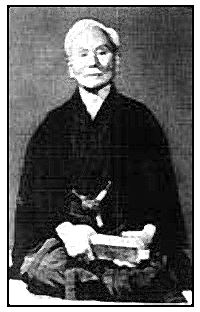
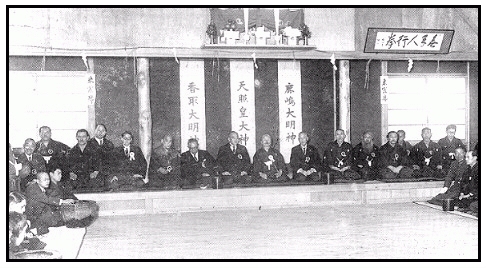
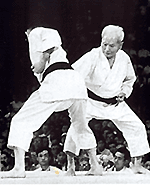 Later, the time came when constructing Funakoshi's own dojo was ripe. About 1935, supporters gathered sufficient funds to construct the first karate dojo in Japan and in 1936 it was dedicated as the Shoto-kan. By now, many initial students who trained with Funakoshi earlier and had moved to other cities due to work, had also created a demand for instruction throughout the country. With the acceptance of karate by other established martial arts and with a growing number of dedicated students, the introduction and popularization of karate in Japan was now well underway.
Later, the time came when constructing Funakoshi's own dojo was ripe. About 1935, supporters gathered sufficient funds to construct the first karate dojo in Japan and in 1936 it was dedicated as the Shoto-kan. By now, many initial students who trained with Funakoshi earlier and had moved to other cities due to work, had also created a demand for instruction throughout the country. With the acceptance of karate by other established martial arts and with a growing number of dedicated students, the introduction and popularization of karate in Japan was now well underway.